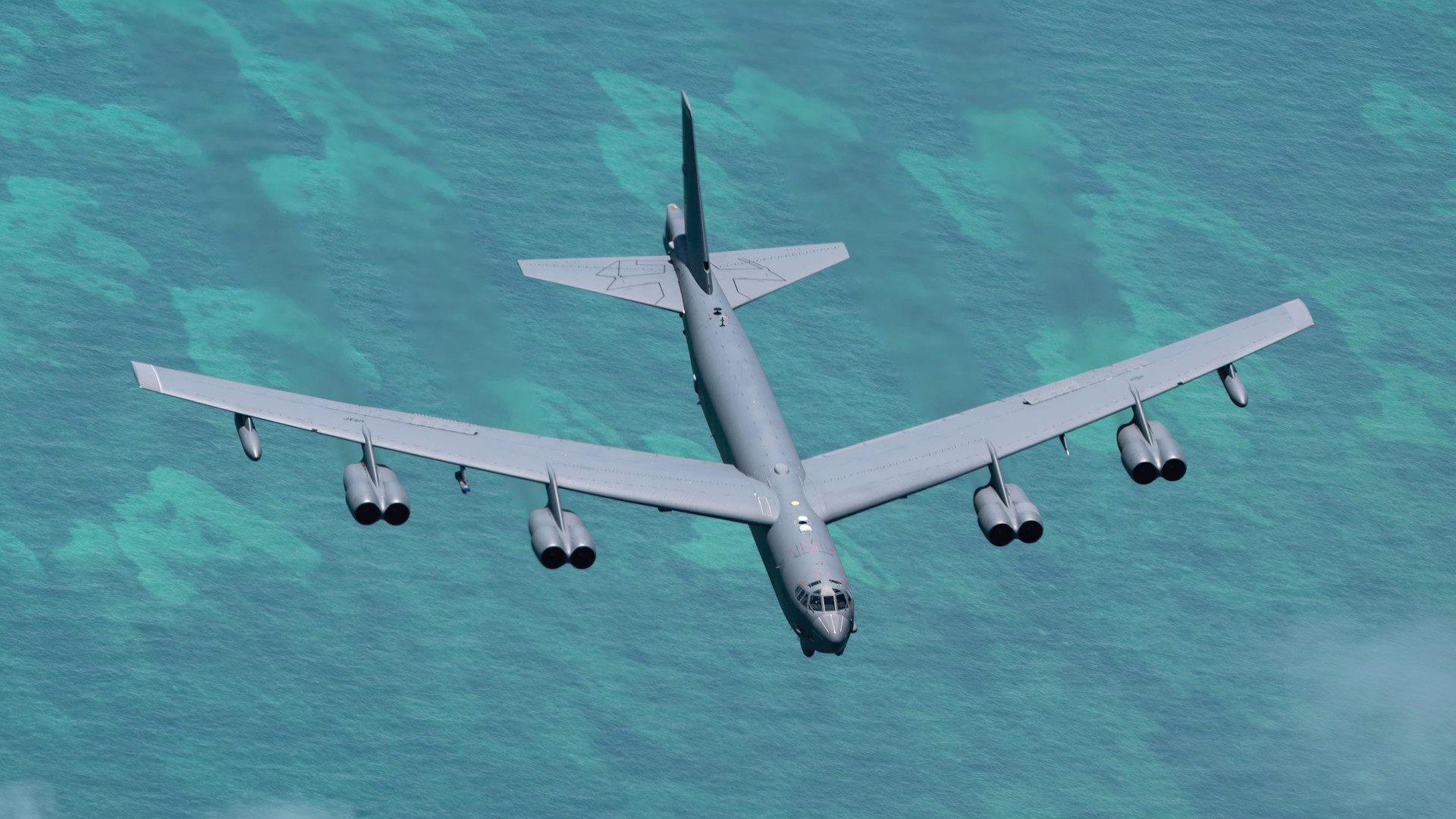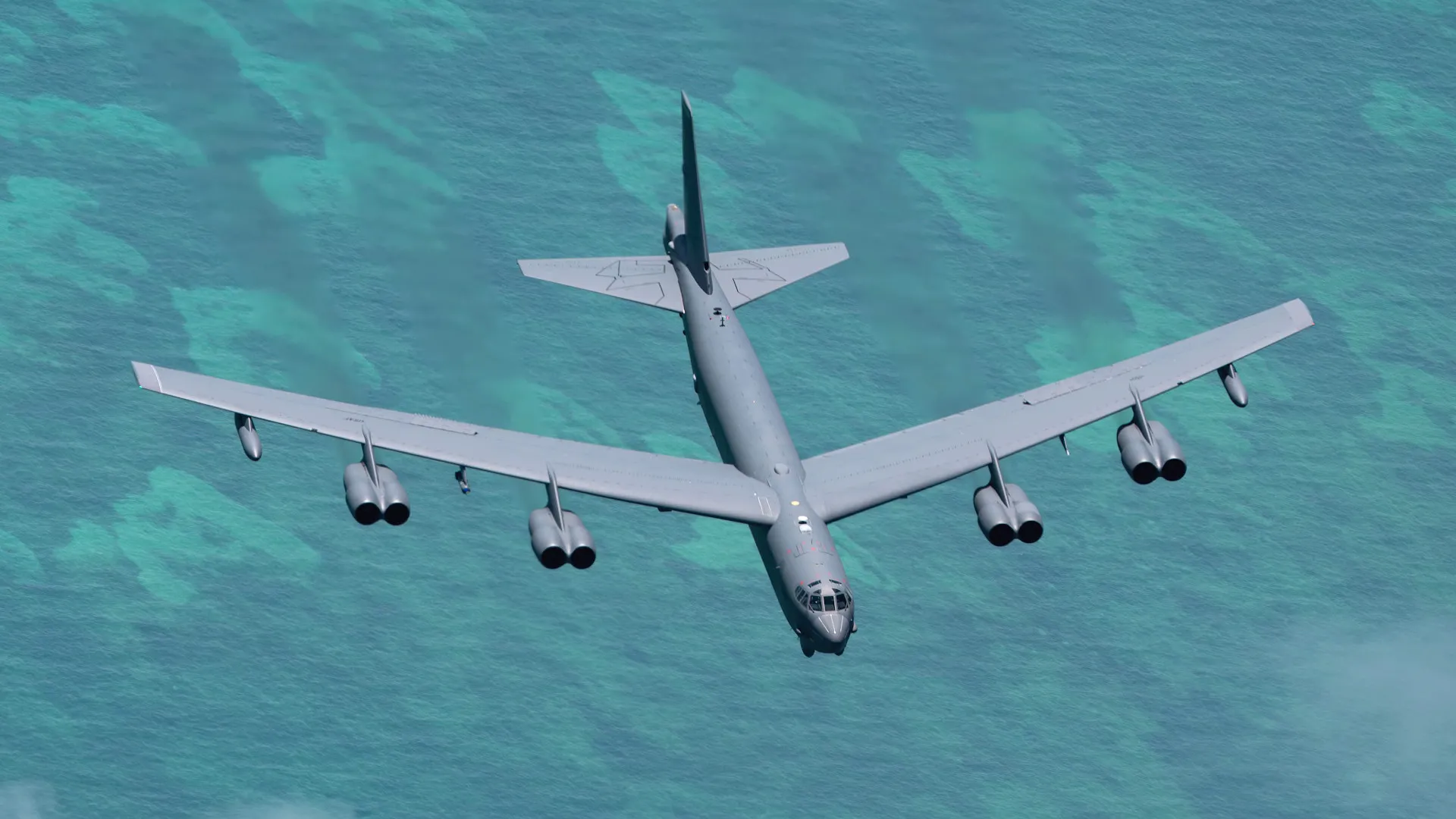
A trio of U.S. Air Force B-52 bombers was tracked flying orbits in international airspace off the coast of Venezuela earlier today. This is a major show of force that comes amid a larger U.S. military buildup in the Caribbean, ostensibly aimed at stemming the flow of illegal drugs north. At the same time, the Trump administration has been focusing particular pressure on the regime of Venezuelan strongman Nicolas Maduro, and the possibility of direct military action, beyond at times lethal maritime interdiction operations, has been steadily growing.
The three B-52s, with the calligns BUNNY01, BUNNY02, and BUNNY03, were tracked leaving Barksdale Air Force Base in Louisiana and heading south early this morning. The bombers subsequently turned east and flew to a patch of international airspace within what Venezuela refers to as the Maiquetía Flight Information Region (FIR).
The B-52s appear to have orbited within the Maiquetía FIR for roughly two hours before departing. U.S. F-35 Joint Strike Fighters, presumably Marine Corps B variants flying from the former Roosevelt Roads Naval Station in Puerto Rico, as well as Air Force aerial refueling tankers and other aircraft, have also been tracked in this same general area in recent weeks.
There are unconfirmed reports that at least one of the Venezuelan Air Force’s pocket fleet of U.S.-made F-16 fighters reportedly took off from El Libertador Air Base, situated to the west of Caracas, while the B-52s were orbiting offshore, but also that this may have been an unrelated training flight. Whether any attempt to intercept the bombers was made is unknown. Maduro did order new snap exercises today in the wake of another lethal U.S. attack on an alleged drug smuggling boat in international waters near Venezuela. In September, he said he had deployed some 25,000 troops to help secure the country’s border areas and key oil infrastructure against potential U.S. threats.
At the time of writing, it is unclear whether or not the B-52s have returned to base or are still airborne. TWZ has reached out to Air Force Global Strike Command (AFGSC) and Air Forces Southern (AFSOUTH) for more information about the bomber sorties into the Caribbean. AFSOUTH directed us to contact the Pentagon.
It is worth noting that B-52s, as well as Air Force B-1 bombers and other U.S. military combat aircraft, have taken part in counter-narcotics operations in the skies over the Caribbean, on and off, for decades now, as you can read more about here. The range and targeting capabilities that the B-52 possesses, in particular, can be useful for spotting and further investigating suspected drug smuggling vessels.
At the same time, openly flying B-52s in such proximity to Caracas seems clearly intended to send a message to Maduro and his regime. The bombers are capable of unleashing waves of standoff cruise missiles and can carry a host of other conventional munitions that can be employed against targets on land and at sea. Though the Venezuelan armed forces have limited air defense capabilities, they could still pose a threat. Standoff strikes from aircraft like the B-52 and other assets would be a likely component of any future U.S. direct action against targets inside the country to help reduce risks to friendly forces. They could even target air defense systems to help clear the way for follow-on operations.
Earlier today, an Air Force C-17 cargo plane was also tracked making an unusual flight straight from Edwards Air Force Base in California to José Aponte de la Torre Airport in Puerto Rico. The purpose of that sortie is currently known. Edwards is the Air Force’s preeminent test base, rather than an installation for operational units.
There has already been a major buildup of U.S. forces in the region, including the deployment, as mentioned, of Marine aircraft to the former Roosevelt Roads Naval Station. Air Force MQ-9 Reapers and now AC-130J Ghostrider gunships have also been spotted flying sorties from Puerto Rico. It is worth pointing out here that AC-130Js are routinely tasked with interdiction and armed overwatch-type missions, including in support of direct action special operations raids.
A host of other U.S. air and naval assets are now operating in the region, as well. This includes the Iwo Jima Amphibious Readiness Group (ARG)/22nd Marine Expeditionary Unit (MEU), several Arleigh Burke class guided missile destroyers, a Ticonderoga class guided missile cruiser, a Los Angeles class nuclear powered fast attack submarine, and even the Ocean Trader, a shadowy special operations mothership.
All told, there are reportedly now some 10,000 U.S. personnel, in total, forward-deployed in the region. Last week, U.S. Southern Command (SOUTHCOM) stood up a new task force, led by elements of II Marine Expeditionary Force (II MEF), to help manage the expanded counter-narcotics operations across the Western Hemisphere.
Since September, U.S. forces have conducted at least five lethal attacks on small boats in the Caribbean, killing numerous individuals, all alleged to have been involved in drug smuggling. President Donald Trump announced the most recent of these just yesterday. Serious questions have been raised about those missions and the legal authorities behind them.
There has otherwise been a steady drumbeat in recent weeks of reporting on the Trump administration’s stepping up of efforts to put pressure on Maduro. Just today, The New York Times reported that Trump has authorized the Central Intelligence Agency (CIA) to undertake covert actions in Venezuela and elsewhere in the Caribbean. Reports last week, citing U.S. officials, said that Trump had ordered an end to efforts to reach a diplomatic resolution to the current impasse with Venezuelan authorities.
Some members of the Trump administration have reportedly been pushing for action to oust Maduro. Since 2020, the dictatorial Venezuelan leader has also been wanted in the United States over drug trafficking and other charges, and American authorities are currently offering a $50 million bounty for his capture.
The appearance today of the three B-52s off Venezuela’s coast marks another major development in the still-expanding U.S. operations in the Southern Caribbean.
Howard Altman contributed to this story.
Contact the author: [email protected]
